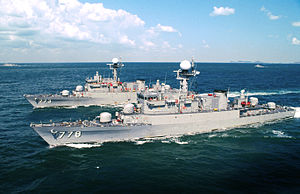Pohang-class corvette

Pohang-class corvette
|
|
| Class overview | |
|---|---|
| Name: | Pohang class |
| Operators: |
|
| Preceded by: | Donghae class |
| Succeeded by: | Incheon class |
| In commission: | 18 December 1984 - present |
| Completed: | 24 |
| Active: | 16 |
| Lost: | 1 |
| Retired: | 7 |
| Preserved: | 1 |
| General characteristics | |
| Type: | Corvette |
| Displacement: | 1,200 tonnes (1,200 long tons; 1,300 short tons) |
| Length: | 88.3 m (289 ft 8 in) |
| Beam: | 10 m (32 ft 10 in) |
| Draft: | 2.9 m (9 ft 6 in) |
| Propulsion: | CODOG unit |
| Speed: |
|
| Range: | 4,000 nautical miles (7,400 km) |
| Crew: | 95 |
| Sensors and processing systems: |
|
| Electronic warfare & decoys: |
|
| Armament: |
|
The Pohang-class corvette (Korean: 포항급 초계함, Hanja: 浦項級哨戒艦) is a class of general purpose corvettes operated by the Republic of Korea Navy. They have served in a coastal defense role during the late Cold War and post Cold War period. A total of 24 Pohang-class vessels were built, all constructed in South Korea. 18 vessels remain in service.
At 21:21:57 (12:21:57 UTC) of 26 March 2010, an explosion (or two explosions) occurred for 1~2 seconds at the stern of ROKS Cheonan, causing a power stoppage and inflow of oil and seawater, and the ship heeled 90 degrees to starboard very quickly. When the crew went out to the deck, they found the stern already submerged. At 22:40, the Navy and the Coast Guard rescued 58 sailors, including the captain, from the crew of 104; 46 were killed. The ship sank around 01:00 on 27 March 2010.
The bow floated 6.4 kilometres (3.5 nmi) to the southeast from the explosion site, then submerged completely at 22:30 on 27 March 2010.
On 20 May 2010, a South Korean-led investigation group announced that all evidence pointed to a North Korean torpedo being responsible for the sinking of Cheonan.
...
Wikipedia
